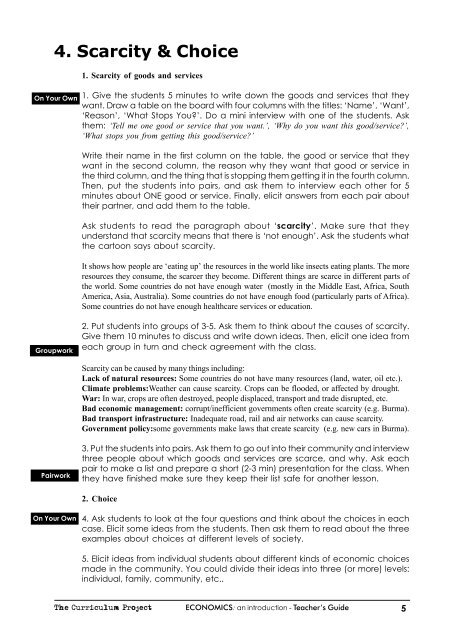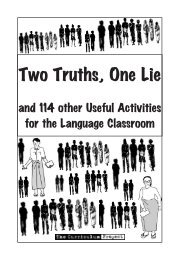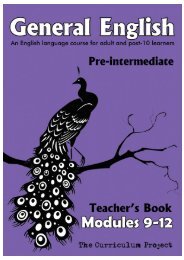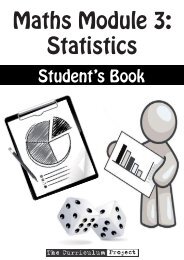Teacher's Guide - The Curriculum Project
Teacher's Guide - The Curriculum Project
Teacher's Guide - The Curriculum Project
- No tags were found...
Create successful ePaper yourself
Turn your PDF publications into a flip-book with our unique Google optimized e-Paper software.
4. Scarcity & ChoiceOn Your Own1. Scarcity of goods and services1. Give the students 5 minutes to write down the goods and services that theywant. Draw a table on the board with four columns with the titles: ‘Name’, ‘Want’,‘Reason’, ‘What Stops You?’. Do a mini interview with one of the students. Askthem: ‘Tell me one good or service that you want.’, ‘Why do you want this good/service?’,‘What stops you from getting this good/service?’Write their name in the first column on the table, the good or service that theywant in the second column, the reason why they want that good or service inthe third column, and the thing that is stopping them getting it in the fourth column.<strong>The</strong>n, put the students into pairs, and ask them to interview each other for 5minutes about ONE good or service. Finally, elicit answers from each pair abouttheir partner, and add them to the table.Ask students to read the paragraph about ‘scarcity’. Make sure that theyunderstand that scarcity means that there is ‘not enough’. Ask the students whatthe cartoon says about scarcity.It shows how people are ‘eating up’ the resources in the world like insects eating plants. <strong>The</strong> moreresources they consume, the scarcer they become. Different things are scarce in different parts ofthe world. Some countries do not have enough water (mostly in the Middle East, Africa, SouthAmerica, Asia, Australia). Some countries do not have enough food (particularly parts of Africa).Some countries do not have enough healthcare services or education.Groupwork2. Put students into groups of 3-5. Ask them to think about the causes of scarcity.Give them 10 minutes to discuss and write down ideas. <strong>The</strong>n, elicit one idea fromeach group in turn and check agreement with the class.Scarcity can be caused by many things including:Lack of natural resources: Some countries do not have many resources (land, water, oil etc.).Climate problems:Weather can cause scarcity. Crops can be flooded, or affected by drought.War: In war, crops are often destroyed, people displaced, transport and trade disrupted, etc.Bad economic management: corrupt/inefficient governments often create scarcity (e.g. Burma).Bad transport infrastructure: Inadequate road, rail and air networks can cause scarcity.Government policy:some governments make laws that create scarcity (e.g. new cars in Burma).Pairwork3. Put the students into pairs. Ask them to go out into their community and interviewthree people about which goods and services are scarce, and why. Ask eachpair to make a list and prepare a short (2-3 min) presentation for the class. Whenthey have finished make sure they keep their list safe for another lesson.On Your Own2. Choice4. Ask students to look at the four questions and think about the choices in eachcase. Elicit some ideas from the students. <strong>The</strong>n ask them to read about the threeexamples about choices at different levels of society.5. Elicit ideas from individual students about different kinds of economic choicesmade in the community. You could divide their ideas into three (or more) levels:individual, family, community, etc..<strong>The</strong> <strong>Curriculum</strong> <strong>Project</strong> ECONOMICS: an introduction - Teacher’s <strong>Guide</strong>5













![[Eng] Nov 2012 DRAFT - The Curriculum Project](https://img.yumpu.com/45590859/1/184x260/eng-nov-2012-draft-the-curriculum-project.jpg?quality=85)


